Abdullah M. Al-Ansi1, Imam Suprayogo2, Munirul Abidin2
1Doctral Program of Educational Management, Islamic State University, Malang, Indonesia
2Educational Management Program, Islamic State University, Malang, Indonesia
Correspondence to: Abdullah M. Al-Ansi, Doctral Program of Educational Management, Islamic State University, Malang, Indonesia.
| Email: |  |
Copyright © 2019 The Author(s). Published by Scientific & Academic Publishing.
This work is licensed under the Creative Commons Attribution International License (CC BY).
http://creativecommons.org/licenses/by/4.0/

Abstract
Information and communication technology have changed the traditional learning approaches to modern and interactive environment. ICTs are the keys of the revolution in education. ICTs in this study were divided into five parts: theory and practice, infrastructure, techniques and methods, devices and tools and educational applications. Learning process were examined in three different levels which are: Secondary schools, undergraduate and postgraduate. This study included main objective which is: analysis the impact of ICT on learning process in different settings of learning in developing countries. Applications of ICT have been explained as part of this study. Quantitative method (surveys) was used in this study. Participants of this study were 144 students of high school (junior and senior levels), 155 students of undergraduate level and 137 of postgraduate were selected randomly. Data were analyzed by SPSS for different surveys. The results of this study were: ICT have positive and significant impact on learning process in high school. ICT factors have positive and significant impact on learning process in undergraduate and postgraduate level except devices and tools of ICT was negative in undergraduate level and insignificant in both levels. In addition to Techniques and methods of undergraduate level was positive but insignificant and infrastructure of higher education was insignificant as well. There is a positive relationship between using of ICT and learning process. Usage and benefits of using ICT applications is more effective in higher levels of education related to many factors such as: policies of learning, difference of abilities, capacity of absorption, specification of studies, extent of need and complexity.
Keywords:
ICT, Learning Process, ICT Applications, Learning Settings, Developing countries
Cite this paper: Abdullah M. Al-Ansi, Imam Suprayogo, Munirul Abidin, Impact of Information and Communication Technology (ICT) on Different Settings of Learning Process in Developing Countries, Science and Technology, Vol. 9 No. 2, 2019, pp. 19-28. doi: 10.5923/j.scit.20190902.01.
1. Introduction
New education depends on new technologies and new technology is changing every single day. Based on this fact, education is continuously changing every single day. Throughout time as technology changes, so do, the ways teachers and students use their own methods of teaching and learning respectively in or out of classrooms. Several years ago, students were using their textbooks to review what they studied in classrooms with their teachers. Nowadays, students can study from their homes and even no need to have teacher as long as there are many learning styles. For example, distance learning allows students to contact universities where ever they are by internet and they can have their textbooks, training, home works and exams through the internet. Traditional learning aims to give knowledge while modern learning is aiming to make education more specific and concentrating on objectives and outcomes of learning. Knowledge is available to all at the current time, not only students can have ideas about specific subject, so the importance of specification of learning in primary and elementary schools will have priority to all who is involved in education process in future.Impact of technology in teaching and learning skills especially after the revolution of the internet can be positive or negative according to utilization of this technology and this impact can be very high or very low connected to level of study [5]. Like many educational reform efforts, the introduction of technology in schools has been less than successful [6]. Over the last century there were several waves of massive investment in technology to improve education, but none has had significant lasting impact on education [7]. The most recent movement to put computers in schools has so far met the same fate as previous attempts. Despite the generous investment in, and increased presence of, computers in schools, computers have been found to be unused or underused in most schools [8]. There are many different approaches of using technology between students in high schools and universities. Technology, especially using laptops, tablets and hand phones, is having a profound effect on education. According to a survey by the Software and Information Industry Association (SIAA, 2010), almost all students have ready access to a mobile device, single or a shared device pool. Student access to mobile devices has now opened the door to a new teaching and learning technology. Paechter, et al. (2009) stated that as new generations of people are exposed to advanced technologies, their applications in educational settings also grow [1]. This diffusion of technology requires well-trained and technologically versatile faculty and school staffs to support this growing demand. The study of educational technology is significant for several reasons. It has been well established that use of current technologies for instructional purposes has great impact on the following: student engagement, learning styles, student-faculty, interactions, faculty satisfaction, and demands for technology use as well as learning outcomes. Nowadays, there are many different styles of education, for example: online learning, blended learning and distance learning. Distance education is a priority because of rising enrolments and the new role of IT in the infrastructure of online instructional programs [2]. The elements of ICT in education are different and significant at the same time based in the importance of technology and rapidly change of it. This study tries to make a group of ICT to make them easier for studying and analysing. ICT in this study divided to five groups which are: theories and practices, infrastructure, techniques or methods, devices or tools and applications of ICT. Description of ICT use in schools and university is the aim of this study. Impact of ICT in learning process will be examined by examining the five factors as well [3].Education in developing countries is affected by many factors such as conflicts, economic situation, socio-cultural life of society, sometimes religions or beliefs and even regulations or policies by governments [4]. This study explores the obstacles and challenges of education in developing countries. This study gives a call for authorities and policies makers of education and government to understand the huge gap between education in their countries and developed countries. Appling modern technology in educational institutions became a necessary to change the traditional approaches. Outcomes of education are very high in developing countries, but no effectiveness and sometimes no jobs for these graduated persons. Changing the way of teaching and learning, minimizing the cost, maximizing the outcomes of learning and effectiveness of tools and educators are the best approaches to keep developing countries challenging the developed ones. This study anlyzes impact of Information and Communication Technology (ICT) on different levels of learning process. This study is also Giving a comperssion between secondary schools, undergraduate and postgraduate levels usage of ICT. Finding solutions to reduce negative use of technology and ways of applying new technologies in educational instituations are analyzed as part of this study as well. This study is looking for new ways for applying and using new technology in education. There are many factors affecting learning process such as: regulations and policies of educational affairs, infrastructure of schools, sociocultural life of society, using technology, experts of educators, and intelligence of students. This study will focus on using modern technology in learning process. So the main hypothesis of this study is “modern technology (ICT) has a positive and significant impact on learning process”. According to previous studies, modern technologies (ICT) includes five different aspects like: theories and practices of ICT, Infrastructure of ICT in schools and institutional organizations, techniques and methods of ICT in learning, devices and tools that help student gaining best profit of technology in learning and analytical, statistical and educational applications.Based on the previous studies and theoretical review, the hypotheses were formed. Here is the framework for using ICT in Learning in all levels of education. This farmework includes five parts of ICT: theory and practice, infrastructure, methods, tools and applications in addtion to learning process.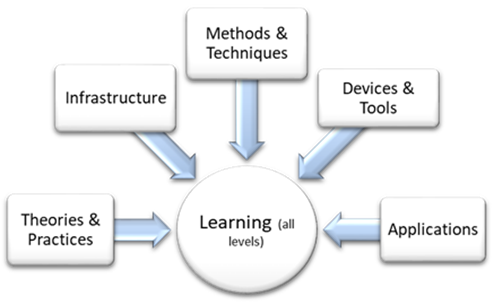 | Figure 1. Framework of Study |
Based on framework, hypotheses of this study were formed as following: H1: Modern Technology (ICT) has positive and significant impact on learning process in secondary schools.H2: Modern Technology (ICT) has positive and significant impact on learning process between undergraduate students.H3: Modern Technology (ICT) has positive and significant impact on learning process between graduate students.
2. Methodology
This study was conducted in three different parts according to the settings of learning (secondary, undergraduate and postgraduate). Based on data collection, quantitative approach was used in this study. This research was conducted in Malang city, Jawa Timur Indonesia. The sample was collected from three schools and one university in districts of Malang and Batu. Table 1. Settings of Learning and Locations
 |
| |
|
Target population in this study is students in high School and University in (Malang, Indonesia) in formal learning. For surveys, 144 students of high school (junior and senior levels), 155 students of undergraduate level and 137 of postgraduate were selected randomly. Sampling technique was Stratified sample where researcher divides the population into groups based on level of learning and then the researcher randomly selected from each group based on its size in participated schools and university. Sample size was determined by Solvin formula: n = N / (1 + Ne ^ 2) where n is sample, N is the population and e is the error tolerance.Table 2. Sample’s Selection
 |
| |
|
According to theoretical studies of ICT, researcher has developed questionnaires to examine use of ICT in high school and both levels undergraduate and postgraduate. Questionnaires included five parts based on ICT Factors. For the first variable of ICT: theories and practices of ICT encompassed 5 questions to measure the use of ICT as theory and practices in classrooms. Second is the infrastructure of ICT which includes both of electrical and radio tools in addition to software that be used online by related collages/school, questionnaire included 5 questions. The third are the techniques and methods of ICT in education questionnaire which included 5 questions. The forth are the devices and tools used in education included 5 questions. The last is the educational applications questionnaire which encompassed 5 questions. Students respondents to each of the 25 items are rated using a 5-point Likert scale with anchors labeled: 1 = strongly disagree, 2 = disagree, 3 = neither agree nor disagree, 4 = agree, 5= strongly agree.The data sources in this study are both primary and secondary data. Primary data was collected by surveys, interviews and investigation. Secondary data was collected from documents, reports and some educational studies and journals. Descriptive statistics includes frequencies and percentages of every item in the questionnaire to describe the ICT and learning process in related school/university. Every item has range for answers between1-5 also every frequency and percentage were collected in addition to the mean (average) and standard deviation. Beside mean, standard deviation, frequency and percentage, there was also a histogram to describe the total sum of every factor of ICT and learning process. Data were analysed by SPSS for surveys and the correlations, comparison, path analysed were used as part of data analysis.
3. Results
According to data collection by surveys, there are three different samples for high school, undergraduate and Postgraduate. Participants in high school survey were 144 students, these participants were selected from both junior and senior high school bilingual Batu school. Junior high school includes classes 7, 8 and 9 while senior high schools include classes 10, 11 and 12. participants in undergraduate surveys were 155 students from seven faculties of UIN-Malang and participants of postgraduate level were 137 selected from faculty of higher education.Table 3. Demographic of Sample
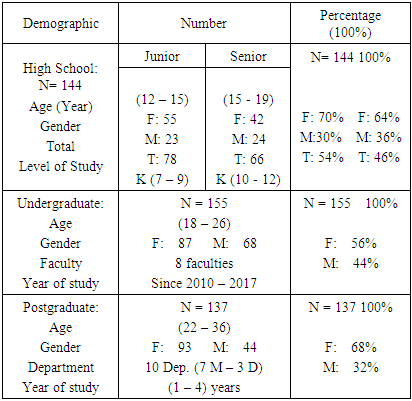 |
| |
|
3.1. Descriptive Statistics Analysis
Descriptive statistics of learning process in high school, undergraduate and postgraduate were determined by surveys with students where most of the answers were strongly agreed (5), agreed (4) and some of them normal (3). Table 4 showed the mean of all instruments of learning in every level of learning. Descriptive statistics for participants of high school surveys of learning process (12 items) are frequencies, percentages and mean. These items for learning process are self-efficacy, intrinsic value, test anxiety, cognitive strategy use and self-regulation. Mean of all items is 3.79 which means there is a good learning process in this school. Most of participants answers where normal with 29.7% and agree with 34.8% which reflect the good satisfaction of learning process that followed in the class rooms by teachers. Descriptive statistics for participants of undergraduate surveys of learning process (10 items) are frequencies, percentages and mean. These items for learning process are evaluative items, curriculum, general & personal), values and beliefs, effort and others. Mean of all items is (3.72) which means there are a good learning perception of student’s side. Table also showed that most of student answers were between normal and agreed while the negative answers were around 10% of all participant answers.Descriptive statistics for participants of postgraduate surveys of learning process (10 items) are frequencies, percentages and mean. These items for learning process are evaluative items, curriculum, general & personal), values and beliefs, effort and others. Mean of all items is (3.91) which means there are a good learning perception of students. Table 4 also showed that most of student answers were between normal and agreed while the negative answers were around 2% of all participant answers.Table 4. Descriptive Statistics of Learning Process
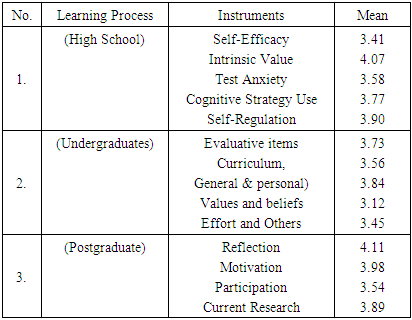 |
| |
|
Descriptive statistics for use of ICT in high schools included 10 items. These items determine the factors of ICT such as theory and practice, infrastructure and applications. Mean of all items is 3.51 which mean there is a good ICT use between students at school. Most of participant’s answers were normal with 33.8%, agree with 30% and strongly agree with 21.7% which reflect the good satisfaction of ICT and its facilities in the class rooms and school. These results showed that 70% of students enjoying use of ICT and they thought it’s enough at school. Descriptive statistics for use of ICT in undergraduate level included 25 items. These items determine the factors of ICT such as theory and practice, infrastructure, method and strategy, devices and tools and educational applications. Mean of undergraduate students was 3.85 which is good value. This means there is satisfaction as 3.94 out of 5 of using technology devices to do their activities. 3.55 use instant massage, streaming videos and researching information about while studying and there is 3.96 out of 5 think that using ICT improves their learning. 3.99 out of 5 of student’s answer think that if ICT ease their learning and 3.85 out of 5 also use social networking for share and connect with friends and lecturers. Mean of all infrastructure answers was 3.70 out of 5 which means there is a good infrastructure in the related university. These results showed that, the infrastructure is not perfect but it is not bad based on high answer of natural. Faculty is highly supported by electricity, audio and television was 3.78 out of 5 same ways with Collage is provided by computers/ laptops for student use any time during study with 3.69 out of the total number 5. Faculty is provided by an active system for student’s registration, administration curriculum and certification management with mean 3.86 while Faculty/ University is provided by related software technology that provides a multi-user environment where can create, store, reuse, manage, and deliver digital educational technology with mean 3.72 out of 5 which means a good condition of infrastructure in UIN- Malang. Based on table 5 the mean of all students’ answer of method used in undergraduate level was 3.45 out of 5 which means there is acceptable method and techniques for using ICT in their learning although this is the lowest answer comparing with other factors affecting learning process between undergraduate students. There are 2.75 out of 5 students skipping some classes when materials from course lectures are available online. 3.81 out of 5 of students use social media to communicate with educators and classmates about course-related topics. There are also 3.63 out of 5 of student’s access to classroom activities and information on mobile devices.Table 5. Descriptive Statistics of ICT
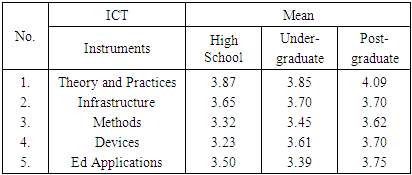 |
| |
|
Mean of all items of ICT devices was 3.61 out of 5 which means a moderate and good usage of electronic devices and tools for learning. Students always use their computer labs or laptops provided by school to do research in addition to personal laptops and cell phones. 3.72 out of 5 of students use cell phone/laptop to enter social media and watch instructional videos on them such as (YouTube). 3.89 out of 5 of students also use projector regularly at classrooms to present their work. Based on table 5 above, educational application mean is 3.39 out of total amount 5 which means a moderate usage of educational applications between students. There are 3.32 out of 5 of students use simulations, programming languages, web-based citation/bibliography tools and educational games. In addition to Faculty/university adopted cloud computing for administration, teaching and enhancing the learning experience for the students. Students also download learning applications in their phone/laptops and use them to develop their skills and researches. Descriptive statistics for use of ICT in postgraduate level included 25 items. These items determine the factors of ICT which are: theory and practice, infrastructure, method and strategy, devices and tools and educational applications. Based on table 5 theory and practice of ICT in postgraduate level, total mean of postgraduate student’s answers was 4.09 which is high value. This means there is satisfaction as 4.16 out of 5 of using technology devices to do their research and activities. 3.86 use instant massage, streaming videos and researching information about while studying and there is 4.21 out of 5 think that using ICT improves their learning. 4.25 out of 5 of student’s answers think that if ICT ease their learning and 4.01 out of 5 also use social networking for share and connect with friends and lecturers. According to table 5 the mean of all answers was 3.70 out of 5 which means there is a good infrastructure in the related university. These results showed that, the infrastructure is not perfect but it is not bad based on high answer of natural. Faculty is highly supported by electricity, audio and television was 3.89 out of 5 same ways with Collage is provided by computers/ laptops for student use any time during study with 3.62 out of the total number 5. Faculty is provided by an active system for student’s registration, administration curriculum and certification management with mean 3.98 while Faculty/ University is provided by related software technology that provides a multi-user environment where can create, store, reuse, manage, and deliver digital educational technology with mean 3.72 out of 5 which means a good condition of infrastructure in UIN- Malang. Mean of all students’ answer about methods and techniques was 3.62 out of 5 which means there is acceptable method and techniques for using ICT in their learning although this is the lowest answer comparing with other factors affecting learning process between Postgraduate students. There are 2.95 out of 5 students skipping some classes when materials from course lectures are available online. 3.89 out of 5 of students use social media to communicate with educators and classmates about course-related topics. There are also 3.75 out of 5 of student’s access to classroom activities and information on mobile devices. Mean of all items was 3.70 out of 5 which means a good usage of electronic devices and tools for learning. Students always use their computer or laptops to do research in addition to personal laptops and cell phones. 3.18 out of 5 of students use cell phone/laptop to enter social media and watch instructional videos on them such as (YouTube). 4.18 out of 5 of students also use projector regularly at classrooms to present their work. Based on table 5 above, educational application mean is 3.75 out of total amount 5 which means a moderate to high usage of educational applications between postgraduate students. There are 3.45 out of 5 of students use simulations, programming languages, web-based citation/bibliography tools and educational games. In addition to Faculty/university adopted cloud computing for administration, teaching and enhancing the learning experience for the students. Students also download learning applications in their phone/laptops and use them to develop their skills and researches.
3.2. Correlations among ICT and Learning Process
Correlation between learning process and ICT applications in high school, undergraduate and postgraduate level was measured. These results showed that there is a positive and acceptable relationship between learning process and usage of ICT in high school while this result is significant at the .01 level which means the more use of ICT the better outcomes of learning process. There are good and high correlation between indicators of ICT with each other with above than eight whereas correlation between these indicators of ICT and learning process was high and positive as well and reflect the real use of ICT between students in undergraduate and postgraduate levels. For undergraduate level, row number in the table 6 showed that learning process and theory and practice of ICT are correlated with .834 which is positive and significant, with infrastructure of ICT .835 which is positive and significant, with method and techniques of ICT .848 which is positive and significant as well. Learning process is correlated with devices and tools of ICT and educational application as .790 and .788 respectively. The correlation between all indicators and learning process is significant at the (P < 0.01) level while our confidence level was (P < 0.08). for postgraduate level, learning process and theory and practice of ICT are correlated with .653 which is positive and significant, with infrastructure of ICT .642 which is positive and significant, with method and techniques of ICT .648 which is positive and significant as well. Learning process is correlated with devices and tools of ICT and educational application as .568 and .587 respectively. The correlation between all indicators and learning process is significant at the (P < 0.01) level while our confidence level was (P < 0.08).Table 6. Correlations Among ICT and Learning Process
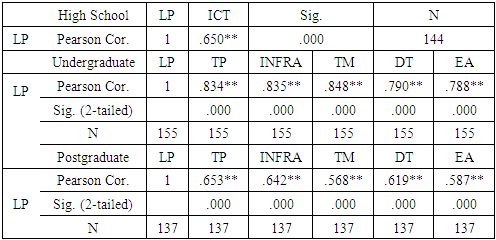 |
| |
|
Where: (LP) is Learning Process, (TP) Theory and Practice, (INFRA) Infrastructure of ICT in Learning, (TM) Techniques and Methods of using ICT in Learning, (DT) Devices or Tools of ICT in Learning, and (EA) Educational Applications in Learning Process.
3.3. Path Analysis
Based on regression analysis and correlation between variables, path analysis could be adapted to measure the impact of ICT on learning process for high school, undergraduate and postgraduate. Table 7 shows the regression analysis for high school, undergraduate and postgraduate levels. Based on the table 7, the adjusted R-squared coefficient for high school multi-variant regression model (information and communication technology and learning process) is 0.722, meaning that only 72.2% of learning process variation is explained by information and communication technology. Standardized coefficient (Beta) of ICT learning process is low and positive (Beta = 0.350) and significant (P =, 000 <, 08) where .08 is the level of confidence in this study. Table 7. Regression Analysis of Variables
 |
| |
|
Examining this model, we would note that there is a slight impact of ICT on learning process between students in high schools. This fact also proved by some studies about using technology in schools. Based on the study framework, a regression model was formed with one independent variable (ICT) and one dependent variable (Learning) as following:  | (1) |
For undergraduate, the adjusted R-squared coefficient for this multi-variant regression model (information and communication technology and learning process) is 0.612, meaning that there is 61.2% of learning process variation is explained by information and communication technology. Standardized coefficient (Beta) of ICT on learning process is divided into five factors as explained in table with theory and practice (Beta = 0.226) and significant (P =, 003 <, 08), infrastructure with (Beta = 0.186) positive and moderate while (P = 0.020 < .08) is significant as well, Techniques and Methods with (Beta = 0.024) which is positive but very low and insignificant with (P =, 765 >, 08), devices and tools with (Beta = -0.012) which is very low and negative where (P = 0.880 > .08) insignificant as well and the last is educational application with (Beta = 0.272) which is positive and moderate where (P = 0.001 < .08) is significant. | Figure 2. Path Analysis for Undergraduate |
For calculating error e for learning process based on ICT, there is the following equation:  | (2) |
By examining this model, we would note that there is a positive and negative impact of ICT on learning process between students in undergraduate level. Theory and practice, educational applications are moderate impact while infrastructure is moderate to low, strategy and method is very low and insignificant and devices/tools is negative and insignificant. So, the second hypothesis of this study which is there is a positive impact of ICT on learning process in undergraduate level was proven in four factors and refused in one factor which is devices and tools of ICT has negative impact on learning process. By using the linear equation, learning process in undergraduate level could be calculated based on usage of ICT as following: | (3) |
For postgraduate level, standardized coefficient (Beta) of ICT on learning process is divided into five factors as explained in table with theory and practice (Beta = 0.286) and significant (P =, 000 <, 08), infrastructure with (Beta = 0.151) positive and moderate while (P = 0.103 > .08) is insignificant, Techniques and Methods with (Beta = 0.352) which is positive and higher than other values and significant with (P =, 000 <, 08), devices and tools with (Beta = 0.057) which is very low but still positive where (P = 0.495 > .08) insignificant as well and the last is educational application with (Beta = 0.026) which is positive and very low where (P = 0.778 > .08) which is insignificant. Drawing path analysis based on regression analysis as following: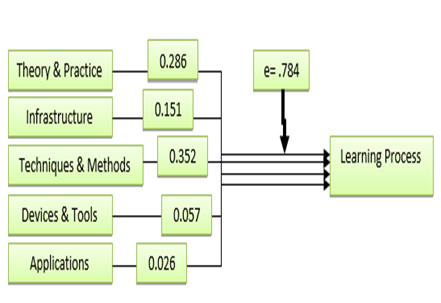 | Figure 3. Path Analysis of Postgraduate |
Linear equation is calculated by the same way where error (e) of learning process based on ICT, there is the following equation: | (4) |
Examining this model, we would note that there is a positive moderate to low impact of ICT in learning process between students in postgraduate level. Theory and practice and infrastructure, are moderate to low impact while techniques and methods is moderate and it’s the best factor affecting learning process in Postgraduate, devices and tools is very low and insignificant and educational application is very low and insignificant. According to results of regression analysis for ICT undergraduate level learning, the linear equation is as follows:  | (5) |
3.4. Comparison Among Settings of Learning
Based on qualitative method, an important role could be formed as following: using ICT increases learning effectiveness and ICT usage increases by increasing level of education. if we simplify this role as high school students use limited ICT courses, ICT devices and use simple methods and applications while in higher education using of ICT as a tool and application are more than high schools. undergraduate students use ICT more than secondary schools and postgraduate students use technology more than all other levels of learning.On the other hand, based on qualitative analysis where participant’s answers showed how they use ICT in learning. The results showed that postgraduate and undergraduate level are the most level using ICT in their learning while in high schools this usage is lower than higher education. Obviously, students at high schools were asked to learn about writing, calculating, reading and memorizing more than using applications for analyzing or doing researches. Students of high schools started take seriously technology as a part of their study and work even they still use it for entertainment more than learning. Results showed in table 8 explain the ratio of using ICT in every level where could notice that in high schools is very low and there are 14 indicators have been found where in postgraduate there are 20 indicators have been found. This table also shows the positive relationship between using of ICT and learning process level. The more learning process is growing up level, the more effective use of ICT. To summarize why using ICT in higher levels (postgraduate and undergraduate) of learning is more effective than lower levels (secondary and high secondary) here are the main points as follows:Table 8. Comparison Among Different Settings
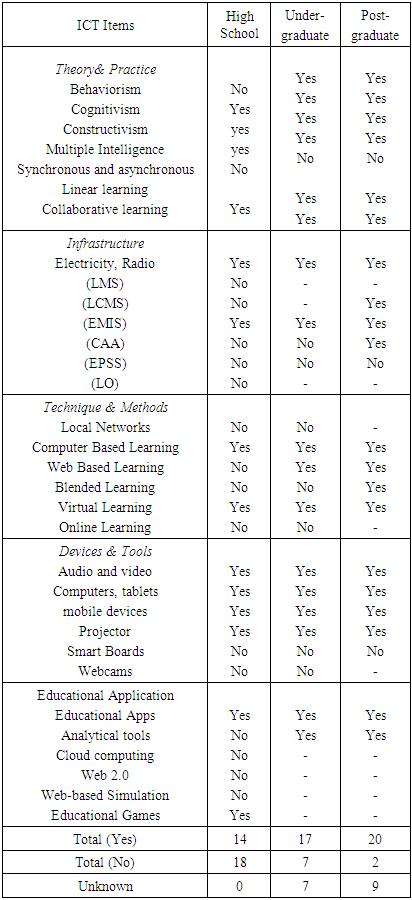 |
| |
|
To summarize why using ICT in higher levels (postgraduate and undergraduate) of learning is more effective than lower levels (primary and secondary) here are the main points as follows:Difference of Abilities: students in Postgraduate and last years of undergraduate level have been learnt many of courses and applications during years of study. They own different abilities more than students in primary and high schools related to differentiation of courses and long-time of learning and gained experiences while students in lower levels of study are still looking for information, knowledge and experiences.Policies of Learning: based on level of learning, there are policies and regulations by specialists and government about using technology in learning. Students in primary and secondary schools are not encouraged to use some electronic devices or online learning at this level heavily. Families keep watch and control use of ICT between their children related to wrong use of the technology or spending much time on using them without doing their homework and social activities. Students in higher levels are encouraged by both family and government to use these devices and also they get support to continue use ICT continuously.Capacity of Absorption: every student has a capacity for learning. When students grow up his capacity is growing up as well. Regardless some special abilities for some students, students in primary and high schools have limited capacity in comparison with students at higher levels of learning. Students in Postgraduate can learn many applications and theories in small time and it’s also easy for them to analyse, investigate and doing academic work while students in primary and secondary schools face some difficulties based on their ages and abilities.Specification of Studies: students at lower levels (primary and secondary education) have to learn writing, reading, calculating and acquiring knowledge in science and social life where students at higher level of education have to study and gain experience at specific subject. When level of learning goes up the specification of study is also going up which means there is a positive and direct relationship between level and specification of study.Extent of need: students at primary and secondary school don’t need ICT intensively; they need this technology as a tool to help them and encourage them to learn while ICT in higher levels of learning is much needed related to differentiations of tasks and requirements of academic research and analysis. Starting from undergraduate, master, doctorate and post doctorate programs level, students have to do presentations, researches and final reports. Students in primary and secondary schools use ICT to look for information and solve some problems.Complexity: nature of learning is one of the reasons why learning by using ICT is very high in Postgraduate and low in lower levels of learning. Curriculum and practices in lower levels are limited and easy while in Postgraduate is very complicated. ICT makes learning and researching easier and better in Postgraduate more than primary and secondary schools where students need to gain knowledge more than using applications of ICT.
3.5. Implementation of ICT in Learning Process
After introducing ICT applications and the approaches of use them in learning in addition to the role of government, schools, teachers and students in every level of learning, here is the model of implementing these applications in every school and educational institutions. Structure of implementation of ICT applications identifies the role of government as the first body for putting the policies and regulation of implementing ICT in educational institutions. Education in many developing countries is managed and supervised by two to three ministries. The second body is the schools, universities and other educational institutions. These institutions have the role of management and implementing the strategies and plans of the government in education. Implementing of ICT applications as shown in the figure 4 is recommended for every educational institution. Some of these applications have been already implemented and other still in process or future plans for many schools. This structure is important for many schools that still use the traditional learning. 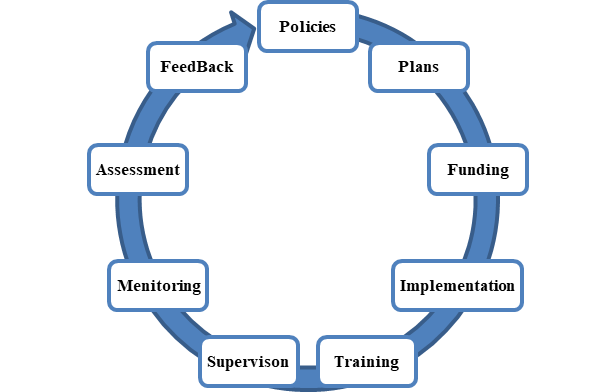 | Figure 4. Implementation of ICT in Learning |
In many developing countries, schools are under the supervision of Ministry of Education (MoE) while the universities under the supervision of Ministry of Postgraduate and Scientific Research (MoHE). Some other developing countries have Ministry of Vocational Education and Technical Training (MoVE) where this ministry is the supervisor of many different educational institutions. Process of implementation ICT applications starts by the first level of education (Government and Ministries) to put the suitable policies and regulations to develop education in all educational institutions. In addition, government plays a critical role in funding and supervision of ICT implementation in educational institutions. Schools and universities have an important role in implementation, supervision, assessment and giving feedback about the process of development ICT. In fact, both of government and schools are completing each other role in the implementation of ICT. Circle of process implementation starts by policies and ends by feedback to start again and again in continuous improvement for education.
4. Discussion
Impact of technology in teaching and learning skills especially after the revolution of the internet can be positive or negative according to utilization of this technology and this impact can be very high or very low connected to level of study [9]. Like many educational reform efforts, the introduction of technology in schools has been less than successful [10]. This study has investigated and explained the impact of ICT in learning process in different level of learning. Based on quantitative analysis, an important impact could be formed as following: using ICT increases learning effectiveness and ICT usage increases by increasing level of education. Therefore, high school students use a limited ICT courses and devices and use simple methods and applications while in higher education gaining of ICT as a tool and application is more than high schools. Same way with undergraduate till postgraduate, undergraduate students use ICT more than secondary schools and postgraduate students use technology more than all other levels of learning.ICT has positive impact on learning process in high schools. Although this impact is significant, but it is very limited in this level of learning. While impact on higher levels of learning are more significant. This result shows the importance of ICT in learning. Schools are recommended to implement ICT as possible as they could. The negative impact of ICT on learning could be reduce by controlling use of electronic devices and internet in schools and universities. There are three hypotheses were formulated to check the impact of ICT applications on learning process. Based on regression analysis of the impact of ICT applications on learning process, the results were as following: (1) ICT has positive and significant impact on learning process in high school learning. (2) ICT has positive impact on leaning process in undergraduate level except devices and tools of ICT has negative and insignificant impact on learning while the other factors of ICT have significant impact. (3) ICT has positive and direct impact on leaning process in postgraduate level and this impact is significant from theory and practices, method and techniques and educational applications and it is not significant from infrastructure and tool and devices. There are good correlations between factors of ICT with each other and positive relationship between them with learning process in all level of learning even this relationship is low in some factors. These results insure the previous studies in the same field of ICT applications on learning which mentioned by some researchers. There is a large body of research that supports the benefits of technology for language acquisition (O’Hara & Pritchard, 2006; Pritchard & O’Hara, 2005; Leu, 2005; Cummins, 2005; Zhao, 2005; Duran, 2005; Egbert, Chao, & Hanson-Smith, 1999; Pennington, 1996; Zhao, 2003). Numerous other studies demonstrate that students who learn in existing multimedia and/or hypertext environments show greater gains in areas of language development than students who learn in more traditional environments (Ayersman, 1996; Boone & Higgins, 1992; Charney, 1994; Martinez-Lage, 1997). Studies investigating the impact of student construction of hypermedia environments on language development came to similar conclusions (Goetze, 2000; Lehrer et al., 1994; Nikolova, 2002). The role of ICT in learning is very significant. Ministry of education and school’s administrations have to be aware of this issue. New education depends on technology totally. Some schools in developing countries have adopted ICT while many schools are still use the traditional learning. This study illustrated the importance of ICT application in learning and showed that there are many benefits to implement this technology in every school. Actually, the negative impact of ICT applications in developing countries school could be controlled easy by the schools especially in primary schools. Students like to learn computer and use internet during learning encourages them to gain many abilities.Becker (1986) reported a comprehensive survey of the instructional uses of computers in United States public and non-public schools. The report suggested that over one million computers were in American elementary and secondary schools and those more than fifteen million students used them during 1985 [11]. The report also says half-a-million teacher used computers during the same period and that half of U.S. secondary schools (about 16,500 schools) owned 15 or more computers [11]. Bergheim and Chin (1984) reported that the US government made available $529 million to schools out of which 60 to70 percent was spent on computer education [12]. Elluh (1989), “technology is progressively effacing the two previous environments: nature and society” (p.134). The environment Elluh talked about is that which enables us to live, sets us in danger and it is immediate to us and mediates all else. He asserted that modern man cannot live without our gadgets. This is what makes human subservient to technology rather that technology being subservient to humanity [13]. The first hypothesis of this study which was proven showed that ICT has positive impact on learning process in high and secondary schools. The second hypothesis of this study was proven in four aspects and refused on one of ICT aspects. Theory and practice, infrastructure and educational application have positive and significant impact on learning process while device and tools of ICT have negative and insignificant impact on learning. Methods and techniques have very low positive impact but are insignificant as well. For postgraduate level, all the ICT factors have positive impact on learning process in postgraduate while some of these impacts are not significant. Interviews also showed the importance of ICT in learning between students in postgraduate where students only use their devices to study, research and write their thesis and dissertations. Testing the last hypothesis of this study which is “there is positive impact of ICT on learning process in postgraduate” showed that this hypothesis is proven as well even there are two factors of ICT insignificant.
5. Conclusions
The conclusion of this study could be summrized in following points as:Impact of ICT on different settings of learning process based on the hypothesis of this study after checking them out according to every factor of ICT in as follows:ICT has positive and significant imapct on high school learning with beta = .350 where level of confidence was p < .00. -Theory and practice of ICT has positive and significant impact on learning process with beta = .22 and .28 for undergraduate and postgraduate prospectively while level of confidence was p < .00. - Infrastructure has positive impact on learning process with beta = .15 and 18 for postgraduate and undergraduate level prospectively where this impact is significant in postgraduate while insignificant in undergraduate level. -Techniques and methods have positive impact on learning process with beta = .024 and .35 for undergraduate and postgraduate prospectively while this impact is significant for postgraduate and insignificant for undergraduate level. -Tools and devices of ICT have positive and very low impact on postgraduate learning with beta = .057 while it is negative and very low on undergraduate learning with beta = -.012 where both levels of learning impact are insignificant. -Educational applications has positive impact on learning process for undergraduate level with beta = .272 and significant while has positive and low impact on postgraduate level learning with beta = .026 and insignificant. There is a positive relationship between ICT usage and learning process level. The higher is level of learning, the better usage of ICT. Implementation of ICT in learning is a long-life issue based on the circle of Implementation which includes elements: policies, plans, funding, implementation, training, supervision, monitoring, assessment and feedback.
ACKNOWLEDGEMENTS
Researcher would like to thank co-authors of this study for their support and comments and all who encourage him during Ph.D. study.
References
| [1] | K. Green, "Campus Computing Project. Educause Conference, November 2009, Denver, CO.," 2009. |
| [2] | A. M. Al-Ansi, "Reforming Education System in Developing Countries," 2017. |
| [3] | V. M. Delgado, "Objective-Based Learning Leads to Real Understanding, Nixon College of Optometry, Ohio State University, 5345 Woodville Ct., Columbus, OH, 43230.," 2006. |
| [4] | Abdullah M. Al-Ansi, "Analysis Impact of Leadership Style and Pay Fairness on Job Satisfaction and Organizational Commitment, Management, Vol. 5 No. 2, 2015, pp. 55-61. doi: 10.5923/j.mm.20150502.05.," 2015. |
| [5] | M. Paechter, "Student expectation of and experiences in e-learning:Their relation to learning achievement and course satisfaction. Journal of Computers and Education 54, 222-229.," 2009. |
| [6] | J. Lucas, "The lack of representation of educational psychology and school psychology in introductory psychology textbooks. Educational Psychology, 25, 347–51.," 2005. |
| [7] | C. Liu, "Do handheld devices facilitate face-to-face collaboration? Handheld devices with large shared display groupware to facilitate group interactions Journal of Computer Assisted Learning 23: 285–299.," 2007. |
| [8] | Q. H. Zhou', "Chemistry teachers' attitude towards ICT in Xi'an', Procedia - Social and Behavioural Sciences, vol. 2, no. 2, pp. 4629-4637.," 2010. |
| [9] | B. Abdu-Raheem, "“Effects of Problem-Solving Method on Secondary School Students’ Achievement and Retention in Social Studies in Ekiti State, Nigeria.” Journal of International Education Research, 8(1), First Quarter.," 2012. |
| [10] | G. T. Alice Thomas, "What Are Some Common Problems With Language?," 2003. |
| [11] | H. Becker, "Computers in the schools. A Recent update. Classroom Computer Learning, January, 96-102.," 1986. |
| [12] | K. Bergheim, "Computers in the classroom. InfoWorld, September 10, 28-37.," 1984. |
| [13] | J. Elluh, "What I believe, Grand Rapids, MI: Erdmann.," 1989. |
| [14] | J. Biggs, Teaching for quality learning at university. Buckingham: The Open University Press., 2003. |












 Abstract
Abstract Reference
Reference Full-Text PDF
Full-Text PDF Full-text HTML
Full-text HTML






